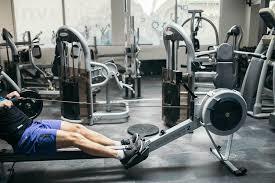
Rowing can be draining and perhaps embarrassing if you don’t use the correct form. If done correctly, you can get a full-body strength training and cardio workout. Here are 7 tips for using a rowing machine.
Contents
Rowing can be divided into four parts: the catch, the drive, the finish, and the recovery.
The catch is your starting position, where your arms should be fully extended just beyond your feet, and your knees and hips should be bent with a straight, strong back.
The drive is the row backwards. Begin by extending your legs, then your torso, followed by your arms.
The finish is your desired end position. Have your legs fully extended, your back straight and slightly sloped beyond 90 degrees, and your arms back with your elbows near your side. Feel free to choose to row high if you want to exercise your rear deltoids more or lower if you want to hit your middle back more.
Finally, the recovery phase is returning to the starting position. Simply, reverse the order of the drive. So the full process is legs, torso, arms, arms, torso, legs.
Most people end up hurting their backs due to not using the machine properly. Make sure you don’t slump over, arch your back, or your shoulders. Instead, keep your back as straight and strong as possible, and your shoulders relaxed.
The important thing is to push and pull in a straight line, not up, to avoid hurting yourself. Also, don’t jerk too hard or do it too quickly; this will not only injure you but also be less beneficial than a well-paced workout. An efficient rowing workout has long and slow strokes.
If you are suffering from back issues, it may be best to avoid rowing altogether or at least consult a physician before risking further injury.
Since using a rowing machine can be tricky at first, don’t jump into it intensely. Do it first for 5 minutes, then for 10 minutes, then for 15. Of course, the longer the exercise, the more benefits you reap. So, once you are capable of a 15-minute rowing workout, stick to it and do it regularly, and you should notice improvements.
If your machine has different resistance levels, start light, and increase as your body allows. Once you’re comfortable taking it to a full workout, follow one of these workout plans.
If you don’t like being watched by others working out at the gym, fortunately there are affordable options out there that allow you to purchase an at-home rowing machine for under $200.
A common mistake made by first-time rowers is to extend the upper body and pull your arms back. This method can turn into a race to exhaust your lower back muscles, which means you won’t row long enough to get a cardio workout.
It’s incredibly important to start the rowing motion by extending your legs, then use that momentum to pull back with your core and finishing with your arms.
Although the focus of rowing is on the legs, it involves different muscles of your body, like the hips, hamstrings, core, back, and glutes. Starting light is recommended to avoid injury.
Other endurance exercises like running and cycling are also an option as they warm up the body by challenging the same body parts and muscles as rowing.
A common mistake at the gym is pulling the handle to the chin or shoulders, probably because it is a longer pull and thus gives the illusion of a better workout. The correct move is to pull to below the pecs to hit the middle back. You can pull high if you want to exercise your rear delts, however just know those muscles generally aren’t as strong and your body isn’t likely to last as long.
Don’t underestimate the power of proper breathing in any workout, not just rowing. Breathing properly keeps you in the safe zone and stops you from rushing or going too hard in your workout. It also helps divide your sequences correctly. Try inhaling during the drive, and exhaling during the recovery.
Rowing is a unique exercise as it combines strength training with cardio. It can be intimidating at first, which is completely normal. Just remember to start slow, light, and that the drive is legs, torso, arms. You’re going to be a pro.